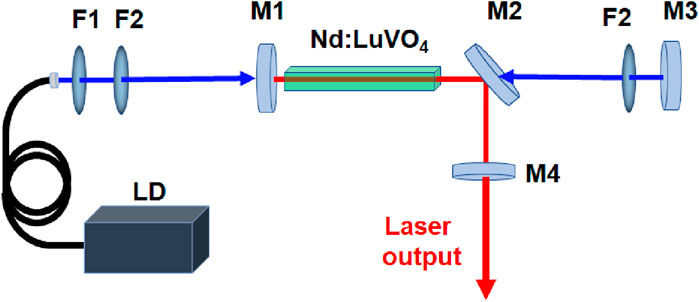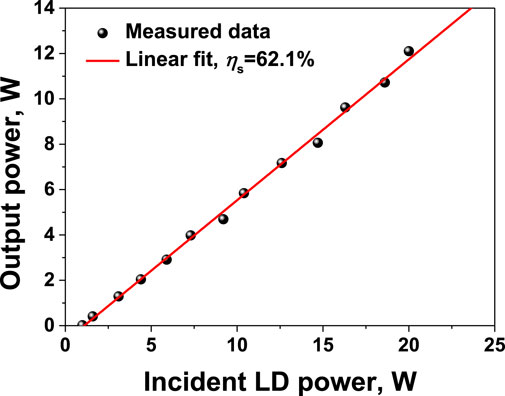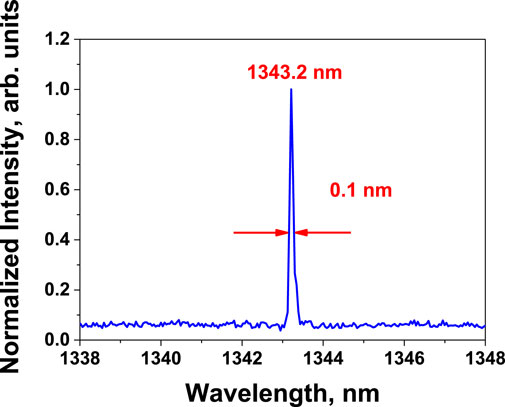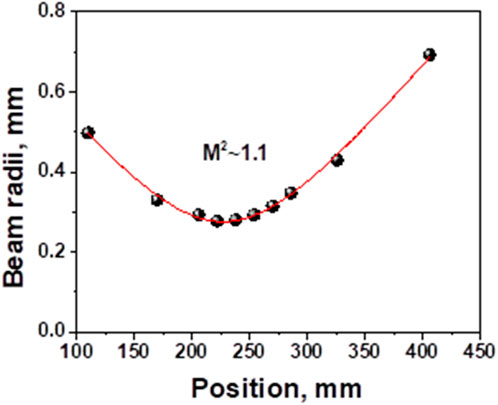- 1The 53th Research Institute of China Electronics Technology Corporation, Beijing, China
- 2National Key Laboratory of Electromagnetic Space Security, Tianjin, China
A high-efficiency Nd:LuVO4 laser, pumped by a fiber-coupled laser diode at 916 nm, was successfully demonstrated. Employing a recycling-pumping architecture, an output power of 12.1 W at 1,343.2 nm was achieved with an incident pump power of 20 W, resulting in a slope efficiency of 62.1% and an optical conversion efficiency of 60.5%. Furthermore, the beam quality factor was measured to be approximately 1.1 at the maximum output level.
1 Introduction
The 1.3 μm diode-pumped solid-state laser has garnered significant attention in various technical applications, including medical and spectroscopy. The transition from 4F3/2 to 4I13/2 of Nd ions represents an outstanding method for generating high-performance 1.3 μm laser radiation. The conventional Nd:YAG crystal has been extensively employed in diode-pumped lasers operating at 1.3 μm [1–3]. Nd-doped vanadate crystals are distinguished by their substantial absorption and emission cross-sections. Consequently, Nd:YVO4 and Nd:GdVO4 crystals represent popular options for producing 1.3-μm laser [4–8]. However, the quantum defect of 39.7% between pump and laser photons constrains the enhancement of output performance of Nd lasers at 1.3 μm. One potential solution involves utilizing a pump wavelength close to 880 nm, enabling the pump photon to directly excite the Nd ions to transition to the laser upper level (4F3/2). This technique, known as in-band pumping technology, leads to a reduced quantum defect and increased efficiency [9–11]. In 2005, researchers demonstrated a Nd:YAG laser operating at a wavelength of 1,341 nm. The laser was pumped by a LD at 885 nm and achieved a slope efficiency of 45% [12]. Similarly, in the same year, a continuous-wave (CW) Nd:GdVO4 laser operating at 1,341 nm was reported, achieving a slope efficiency of 60% under the pumping of an 879 nm Ti:Sapphire laser [13]. In 2008, a Nd:YVO4 laser operating at 1,342 nm was demonstrated using a Q-switched Ti:Sapphire laser at 879 nm [14]. Moving forward to 2010, researchers demonstrated a CW Nd:YLF laser operating at 1,321 nm. The laser had an output power of 3.6 W and a slope efficiency of 52%. It was achieved using a fiber-coupled LD at 880 nm [15]. In 2018, the 1.3-μm lasing performances of Nd:Gd0.69Y0.3TaO4 and Nd:Gd0.68Y0.3NbO4 mixed crystals were investigated under 879-nm LD pumping [16].
The Nd:LuVO4 crystal exhibits larger absorption and emission cross sections compared to Nd:YVO4 and Nd:GdVO4, making it a suitable choice for use as the laser medium in the near-infrared spectral region. Nd:LuVO4 lasers operating at 0.9 μm, 1.06 μm, and 1.3 μm wavelengths have been reported, utilizing laser diode (LD) pumping near 808 nm [17–19]. In 2010, Nd:LuVO4 lasers achieved output powers of 7.0 W and 6.2 W at 1,343 nm when pumped at 880 nm and 809 nm, corresponding to the slope efficiencies of 44.5% and 34.9% with respect to absorbed pump power, respectively [20]. In addition to the absorption peaks at 809 nm and 880 nm, the Nd:LuVO4 crystal also exhibits a significant absorption peak at 916 nm. By utilizing this absorption peak for pumping, the quantum defect in Nd:LuVO4 lasers operating at 1,343 nm can be reduced to 31.8%. This reduction results in higher efficiency and lower thermal loading for the laser system. In 2013, a Nd:LuVO4 laser pumped by a diode-pumped 916-nm Nd:LuVO4 laser achieved an output power of 1.12 W at 1,343 nm. This corresponds to a slope efficiency of 61.9% relative to the absorbed pump power [21].
In this paper, to the best of our knowledge, a high-efficiency Nd:LuVO4 laser at 1,343 nm that is recycling-pumped by a fiber-coupled LD at 916 nm was demonstrated. By utilizing this approach, we achieved the maximum output power of 12.1 W at 1,343.2 nm, with an incident pump power of 20 W. This corresponds to a slope efficiency of 62.1% and an optical conversion efficiency of 60.5%. Furthermore, the beam quality factor (M2) was estimated to be approximately 1.1 at maximum output power.
2 Experimental setup
The experimental setup of a diode-pumped Nd:LuVO4 laser with a recycle pumping scheme was shown in Figure 1. The pump source utilized in the experiment was a wavelength-locked fiber-coupled LD with a maximum output power of 20 W at 916 nm. The pigtail fiber had a core diameter of 105 μm and a numerical aperture of 0.22. To focus the pump beam into the Nd:LuVO4 crystal, a telescope comprising lenses F1 and F2 was employed, with focal lengths of 15 mm and 60 mm, respectively, resulting in a pump spot radius of 210 μm. A c-cut Nd:LuVO4 crystal with a doping concentration of 1.0 at.% and dimensions of 3 × 3 (in cross-section) ×10 (in length) mm3 was used in the experiment. Both surfaces of the crystal were antireflection coated from 900 nm to 1,400 nm. The crystal, wrapped in indium foil, was mounted in a copper heatsink, with the operating temperature maintained at 18 °C using a thermoelectric cooler. The single-pass pump absorption of the Nd:LuVO4 crystal was measured to be approximately 80% under nonlasing conditions.
The laser cavity consists of three mirrors. To achieve a lasing wavelength of 1,343 nm, the flat M1 mirror was coated with high transmission at wavelengths of 916 nm and 1,066 nm, as well as high reflectivity at the lasing wavelength of 1,343 nm. The M2 mirror was a flat 45° dichromatic mirror with high transmission at 916 nm and high reflectivity at 1,343 nm. In the experiment, an output coupler M4 with a plano-concave shape and a radius of curvature of 200 mm was used, with an output transmittance of 25%. The physical length of the cavity was approximately 50 mm. The flat M3 mirror, which had high reflectivity at 916 nm, and another lens F2 were utilized to achieve pump recycling.
3 Experimental results
Figure 2 displays the output powers of the Nd:LuVO4 laser, which were measured using a Coherent PM 30 power meter. With an LD pump at 916 nm, a maximum output power of 12.1 W was achieved under an incident LD power of 20 W, resulting in a slope efficiency of 62.1% and an optical conversion efficiency of 60.5%. The pump threshold for the laser was approximately 1.0 W. In addition, the power fluctuation was about 2.1% within a period of 1 hour. Higher temperature-control accuracy and narrower output linewidth can improve the power stability. Limiting the pump power, more high output power was not presented in this work. No power saturation phenomenon was observed in Figure 2. We believe that output power could be increased under higher pump level. Furthermore, optimizing the overlap between pump and oscillating beams and output transmittance could further improve output performance.
The output spectra of Nd:LuVO4 laser were recorded by a laser spectrum analyzer (Bristol, 771B). As depicted in Figure 3, a single oscillating line at 1,343.2 nm was observed, with an FWHM linewidth of approximately 0.1 nm. Throughout the increase in pump power from threshold to maximum level, no other wavelengths were detected.
The beam quality factor of Nd:LuVO4 laser was measured by the 90/10 knife-edge method, as shown in Figure 4. The estimated value at maximum output power was approximately 1.1. Furthermore, images of the far-field beam in both 2D and 3D were captured using a camera (Ophir-spricon, Pyrocam IV), as illustrated in Figure 5. These images clearly indicate that the beam exhibits a TEM00 Gaussian profile.
4 Conclusion
In conclusion, this work presents the successful demonstration of an efficient recycling-pumped Nd:LuVO4 laser, achieved using a wavelength-locked fiber-coupled LD at 916 nm. The laser attained a maximum output power of 12.1 W at 1,343.2 nm with an incident pump power of 20 W, resulting in a slope efficiency of 62.1% and an optical conversion efficiency of 60.5%. Furthermore, the M2-factor at maximum output level was measured to be approximately 1.1. These results highlight promising prospects for enhancing the output power at 1,343 nm for the Nd:LuVO4 laser.
Data availability statement
The raw data supporting the conclusion of this article will be made available by the authors, without undue reservation.
Author contributions
WD: Writing–original draft, Data curation, Writing–review and editing. TL: Investigation, Supervision, Writing–review and editing. YD: Investigation, Methodology, Writing–original draft. YuZ: Data curation, Formal Analysis, Writing–review and editing. YoZ: Methodology, Validation, Writing–review and editing.
Funding
The author(s) declare that no financial support was received for the research, authorship, and/or publication of this article.
Conflict of interest
The authors declare that the research was conducted in the absence of any commercial or financial relationships that could be construed as a potential conflict of interest.
The handling editor XD declared a past Authorship with one of the authors YD.
Publisher’s note
All claims expressed in this article are solely those of the authors and do not necessarily represent those of their affiliated organizations, or those of the publisher, the editors and the reviewers. Any product that may be evaluated in this article, or claim that may be made by its manufacturer, is not guaranteed or endorsed by the publisher.
References
1. Hall GJ, Ferguson AI. Generation of single-frequency radiation at 1064, 1319, and 659.5 nm with an all-solid-state, out-of-plane Nd: YAG ring laser. Opt Lett (1994) 19(8):557–9. doi:10.1364/ol.19.000557
2. Guo R, Hong FL, Onae A, Bi ZY, Matsumoto H, Nakagawa K. Frequency stabilization of a 1319-nm Nd: YAG laser by saturation spectroscopy of molecular iodine. Opt Lett (2004) 29(15):1733–5. doi:10.1364/ol.29.001733
3. Liu H, Gong M, Wushouer X, Gao S. Compact corner-pumped Nd: YAG/YAG composite slab 1319 nm/1338 nm laser. Laser Phys Lett (2010) 7(2):124–9. doi:10.1002/lapl.200910124
4. Sennaroglu A. Efficient continuous-wave operation of a diode-pumped Nd:YVO4 laser at 1342 nm. Opt Commun (1999) 164(4-6):191–7. doi:10.1016/s0030-4018(99)00195-9
5. Zhao S, Huang HT, He JL, Zhang BT, Yang JF, Xu JL, et al. An efficient and compact diode end-pumped Nd: YVO4 slab laser. Laser Phys Lett (2009) 6(8):571–4. doi:10.1002/lapl.200910044
6. Ogilvy H, Withford MJ, Dekker P, Piper J. Efficient diode double-end-pumped Nd: YVO4 laser operating at 1342nm. Opt Express (2003) 11(19):2411–5. doi:10.1364/oe.11.002411
7. Du C, Ruan S, Zhang H, Yu Y, Zeng F, Wang J, et al. A 13.3-W laser-diode-array end-pumped Nd: GdVO4 continuous-wave laser at 1.34 μm. Appl Phys B (2005) 80:45–8. doi:10.1007/s00340-004-1687-z
8. Du C, Qin L, Meng X, Xu G, Wang Z, Xu X, et al. High-power Nd: GdVO4 laser at 1.34 μm end-pumped by laser-diode-array. Opt Commun (2002) 212(1-3):177–81. doi:10.1016/s0030-4018(02)01978-8
9. Pavel N, Kränkel C, Peters R, Petermann K, Huber G. In-band pumping of Nd-vanadate thin-disk lasers. Appl Phys B (2008) 91:415–9. doi:10.1007/s00340-008-3013-7
10. Duan X, Wu J, Ding Y, Yang X, Dai T. Electro-optically Q-switching of dual-diode-pumped Ho-doped lutetium vanadate laser. Opt Laser Technol (2023) 158:108929. doi:10.1016/j.optlastec.2022.108929
11. Wu J, Ju Y, Duan X, Yan R, Ding Y, Yan D, et al. Electro-optically Q-switching performance of diode-pumped Ho: GdVO4 laser at 2.05 μm. Opt Laser Technol (2023) 158:108845. doi:10.1016/j.optlastec.2022.108845
12. Pavel N, Lupei V, Taira T. 1.34-μm efficient laser emission in highly-doped Nd: YAG under 885-nm diode pumping. Opt Express (2005) 13(20):7948–53. doi:10.1364/opex.13.007948
13. Saikawa J, Sato Y, Taira T, Nakamura O, Furukawa Y. Efficient 1341-nm laser emission and heat generation characteristics in Nd:GdVO4 laser under direct 879-nm pumping. In: Advanced solid-state Photonics. Optica Publishing Group (2005). p. MB48. doi:10.1364/ASSP.2005.MB48
14. Ding X, Zhang H, Wang R, Wen WQ, Wang P, Yao JQ, et al. High-efficiency direct-pumped Nd:YVO4 laser operating at 1.34 μm. Opt Express (2008) 16(15):11247–52. doi:10.1364/oe.16.011247
15. Lü YF, Xia J, Zhang XH, Zhang AF, Wang JG, Bao L, et al. High-efficiency direct-pumped Nd:YLF laser operating at 1321 nm. Appl Phys B (2010) 98:305–9. doi:10.1007/s00340-009-3792-5
16. Yan RP, Zhao C, Li X, Li K, Yu X, Yao W, et al. Investigation on 1.3 μm laser performance with Nd:Gd0.69Y0.3TaO4 and Nd:Gd0.68Y0.3NbO4 mixed crystals. Opt Express (2018) 26(12):15785–92. doi:10.1364/oe.26.015785
17. Zhang C, Zhang L, Wei Z, Long Y, Zhang Z, Zhang Z, et al. Diode-pumped continuous-wave Nd: LuVO4 laser operating at 916nm. Opt Lett (2006) 31(10):1435–7. doi:10.1364/ol.31.001435
18. Maunier C, Doualan JL, Moncorgé R, Speghini A, Bettinelli M, Cavalli E. Growth, spectroscopic characterization, and laser performance of Nd:LuVO4 a new infrared laser material that is suitable for diode pumping. JOSA B (2002) 19(8):1794–800. doi:10.1364/josab.19.001794
19. Zhang H, Liu J, Wang J, Xu X, Jiang M. Continuous-wave laser performance of Nd:LuVO4 crystal operating at 1.34 µm. Appl Opt (2005) 44(34):7439–41. doi:10.1364/ao.44.007439
20. Lü YF, Zhang XH, Chen JF, Sun G, Zhao Z. All-solid-state Nd:LuVO4 laser operating at 1066 nm and 1343 nm under diode pumping into the emitting level. Laser Phys Lett (2010) 7(10):699–702. doi:10.1002/lapl.201010045
Keywords: diode-pumped lasers, Nd lasers, in-band pump, recycling-pump, Nd:LuVO4
Citation: Dai W, Liu T, Ding Y, Zhao Y and Zhang Y (2024) High-efficiency Nd:LuVO4 laser at 1343 nm recycling-pumped by a laser diode at 916 nm. Front. Phys. 12:1388372. doi: 10.3389/fphy.2024.1388372
Received: 19 February 2024; Accepted: 20 March 2024;
Published: 18 April 2024.
Edited by:
Xiaoming Duan, Harbin Institute of Technology, ChinaReviewed by:
Zhenxu Bai, Hebei University of Technology, ChinaLiu Xuesheng, Beijing University of Technology, China
Xin-Xing Zhang, Dalian University of Technology, China
Preeti Gupta, Leibniz Institute for Solid State and Materials Research Dresden (IFW Dresden), Germany
Copyright © 2024 Dai, Liu, Ding, Zhao and Zhang. This is an open-access article distributed under the terms of the Creative Commons Attribution License (CC BY). The use, distribution or reproduction in other forums is permitted, provided the original author(s) and the copyright owner(s) are credited and that the original publication in this journal is cited, in accordance with accepted academic practice. No use, distribution or reproduction is permitted which does not comply with these terms.
*Correspondence: Yu Ding, ZGluZ195dTEyM0AxNjMuY29t
 Wantian Dai1
Wantian Dai1 Yu Ding
Yu Ding



